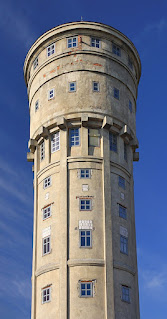How water towers work and for what purpose they are built ?
A water tower ( Water tower / Wasserturm ) also associated as a water tower is a building structure. It is designed to independently regulate the pressure and control the flow of water in a hydraulic system covering a small area where it is erected. A water tower is an object that bases its operation on the simple laws of physics. It has many of the functional features on which the foundations of the water infrastructure module planned for the industrial, urban and railroad sectors are based. Principle of water tower operation
.jpg)
How water towers work and for what purpose they are built ? / photo by HarshLight from San Jose, CA, USA
A priority feature in the design of a water tower is the search for a suitable site for the future foundations of the structure. The structure, in order to be fully functional, must be built on the highest local elevation. Because the accumulating water in the water tower's tank must be located higher than the water systems located at the customers. The scheme of operation of the entire hydraulic system, based on the water tower, is that the pump sucks water from the deep reservoir, pumping the liquid upward, directly into the water tank, which is located at the top of the water tower. Then, under the influence of its gravity and thanks to the law of gravity, it displaces the water from the pipes until the pressure in the tower tank becomes equal to the pressure in the entire pipeline hydraulic system ( Pascal's Law ). So the whole process of functioning of the water tower operation is based on the phenomenon of hydrostatic equilibrium, working on the principle of fluid flow in " connected vessels ".
Purpose of the water tower
In addition to autonomously stabilizing the flow of water, the water tower has several other practical features. When steam pumps were displaced by electric pumps. The role of the water tower was designated to act as a water reserve for the hydraulic system. The water circulation begins at the pumping station and reaches consumers through filters. In between, the tower reservoir is replenished with water until the water level of the reservoir is reached at an appropriate standard.
During the peak period of water intake by consumers, the hydraulic system operating in the area is overloaded and the pump station cannot cope with the water flow rate. A shut-off valve is opened in the reservoir and water from the tower additionally feeds the piping system. If the performance of the pump station improves, the valve again closes the flow of water from the reservoir, and the pumps return to their work. The above water circulation in the hydraulic system is cyclic.
Functionality of the water tower
In the old days, the erection of water towers was indeed a very important event. These hydraulic marvels of technology were able to relieve residents of basic household chores. Imagine carrying buckets of water to the fourth floor of a building !!! - something awful. The water tower was able to relieve people and delivered water to the upper floors by itself. But immediately what about hot water ? A lot of water towers were connected to the boiler house and chimney. The water was heated and delivered to the taps. It is wonderful to have hot water on tap and without leaving the house.
History of the water tower
The water tower is not an invention of our time. Since ancient Roman times, aqueducts have been built to supply cities with fresh water from mountain streams based on the principles of gravity. The mountains are a great analogy depicting the water tower scheme. The heyday of water tower construction came at the turn of the 20th century. During this period, water towers were used to store water in urban and industrial areas, and also played an important role in railroad infrastructure ; supplying locomotives and real estate with water.
Diagram of water tower construction
A water tower consists of several elements ; structural and mechanical.
Plinth
The structure can be made of wood, red brick, reinforced concrete, riveted or welded steel plates. The water tower has a solid foundation, outlined in a circular, square or other geometric shapes. The tower's foundation usually consists of a massive plinth, which is made of hewn stone, ceramic bricks or reinforced concrete block.
The trunk ( support)
The next important element included in the water tower structure is the stem, also called the support, which is set vertically between the base and the head. In the center of the element are stairs leading to the tank and a network of pipes responsible for pumping and piping water. The elevation of the stem usually does not differ architecturally from the rest of the structure. It usually takes on a narrow cylindrical shape with a vertical arrangement and is thus easy to recognize. The stem of the water tower additionally has windows, allowing for proper illumination of the object's interior.



Comments
Post a Comment